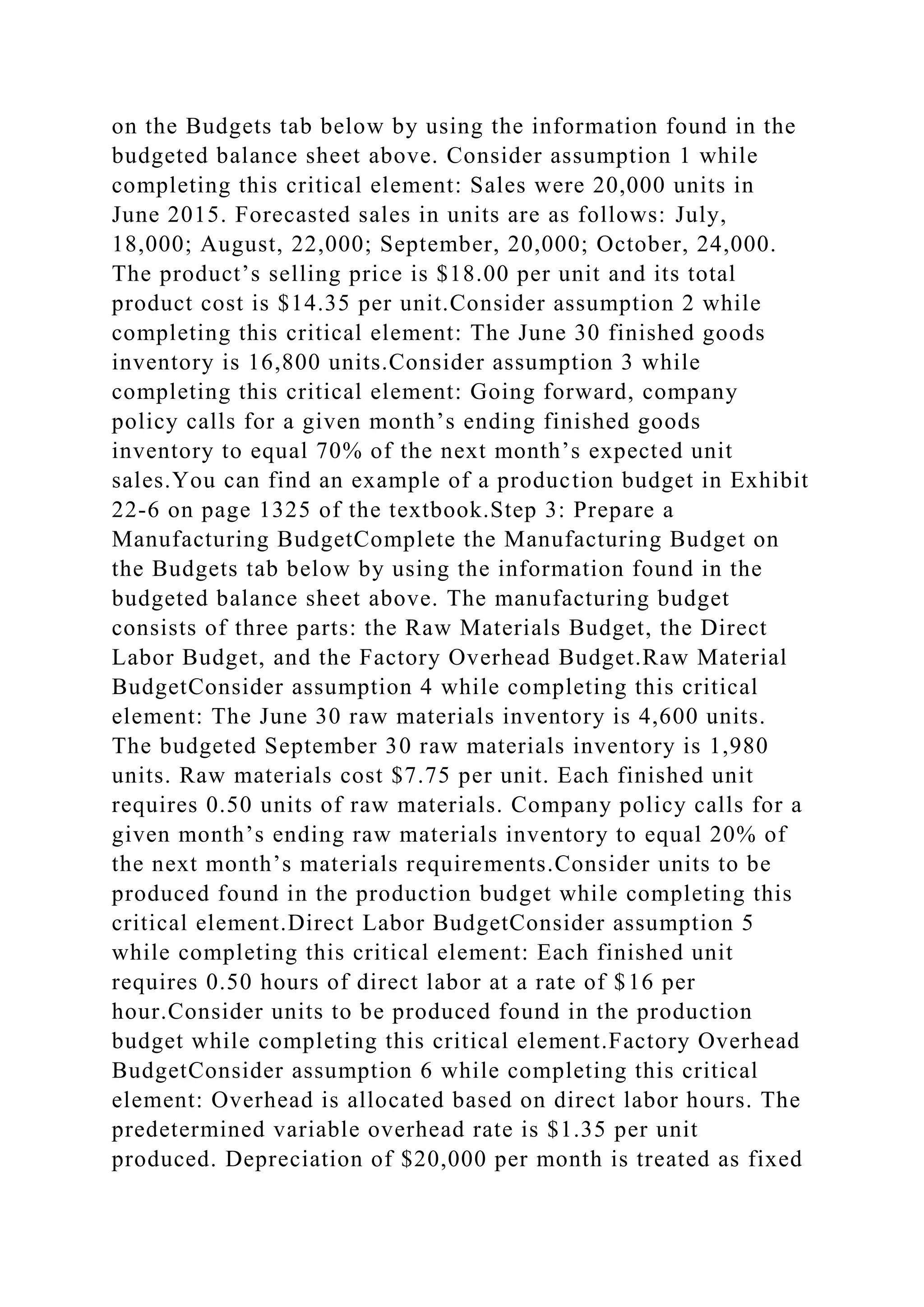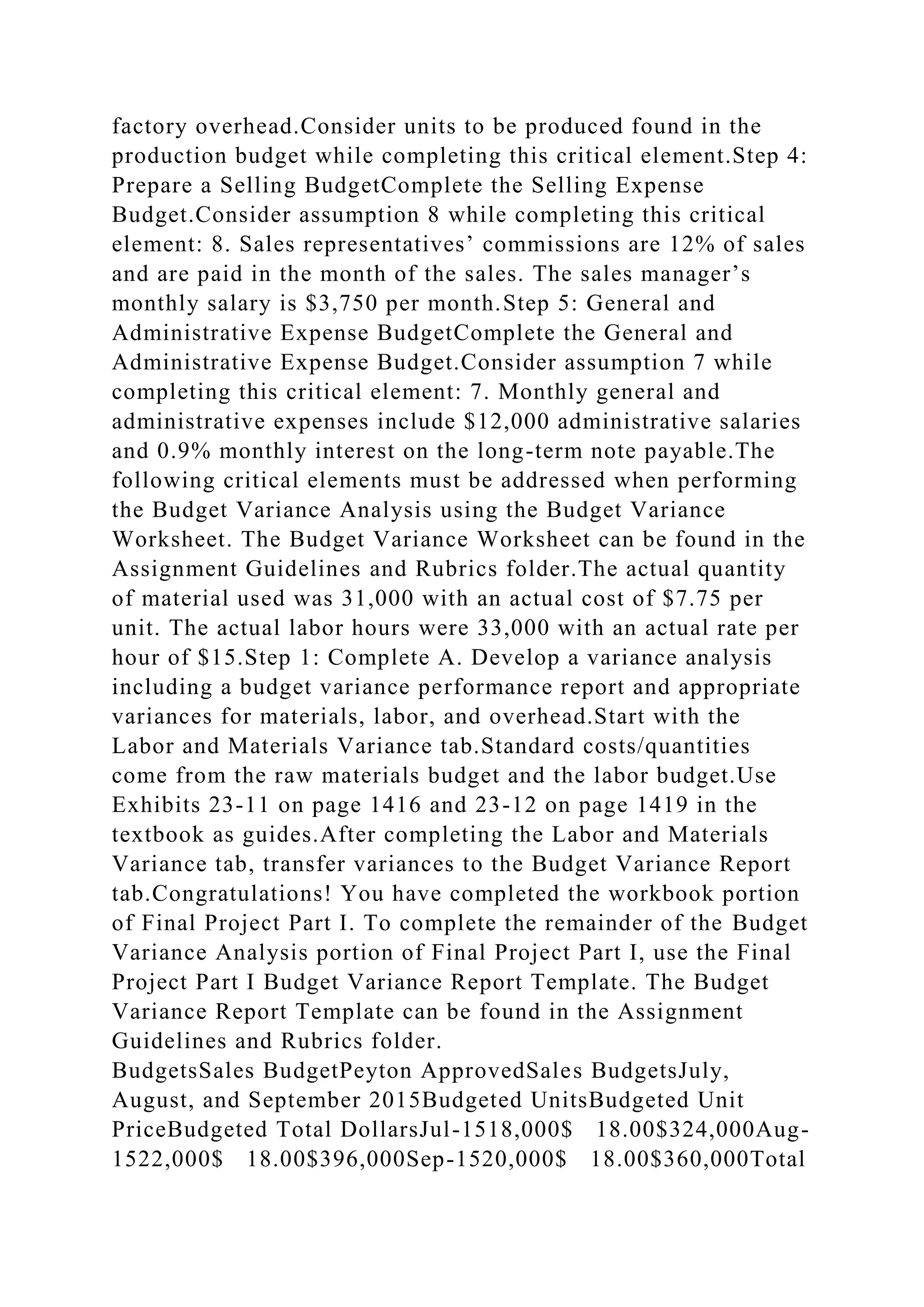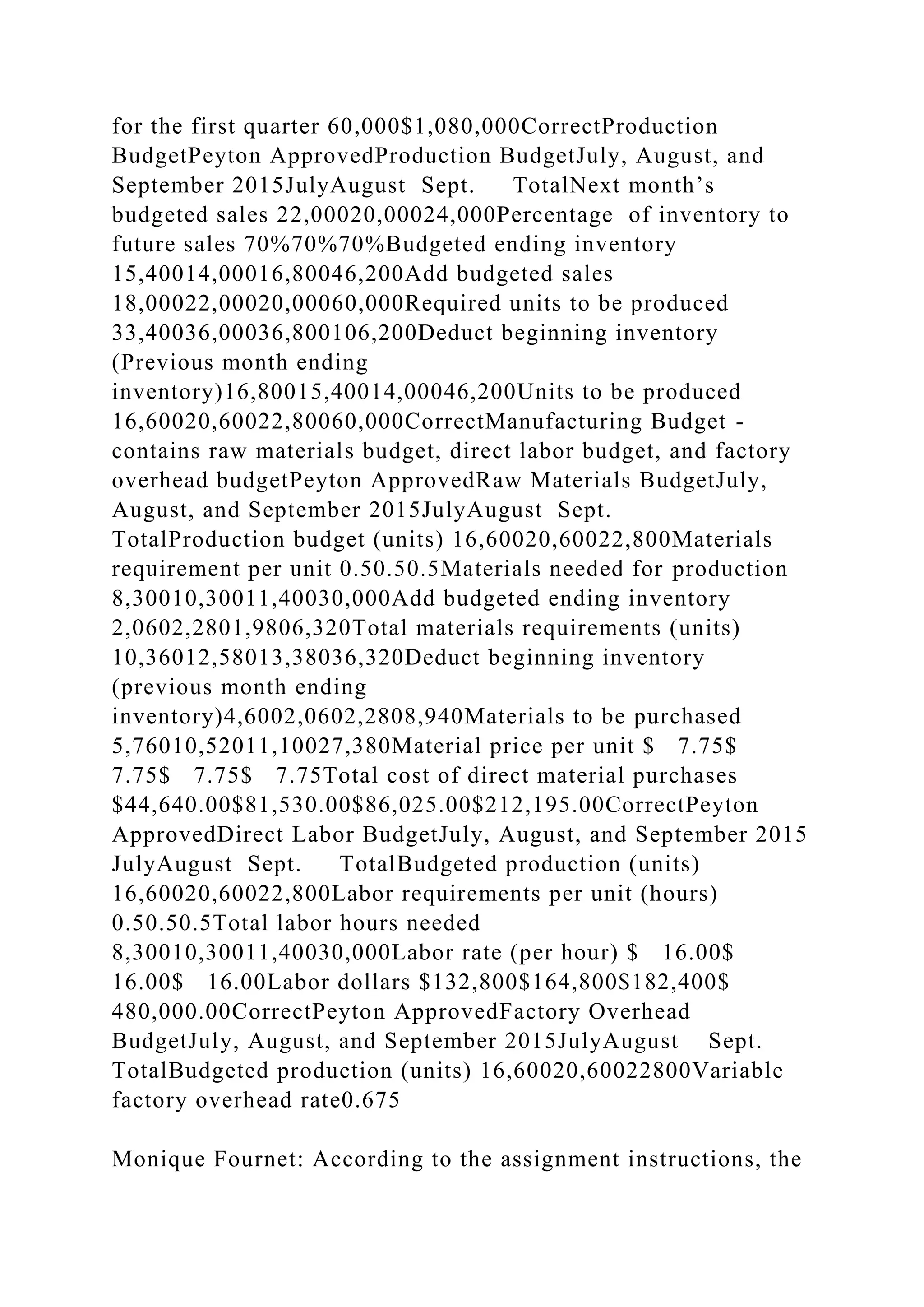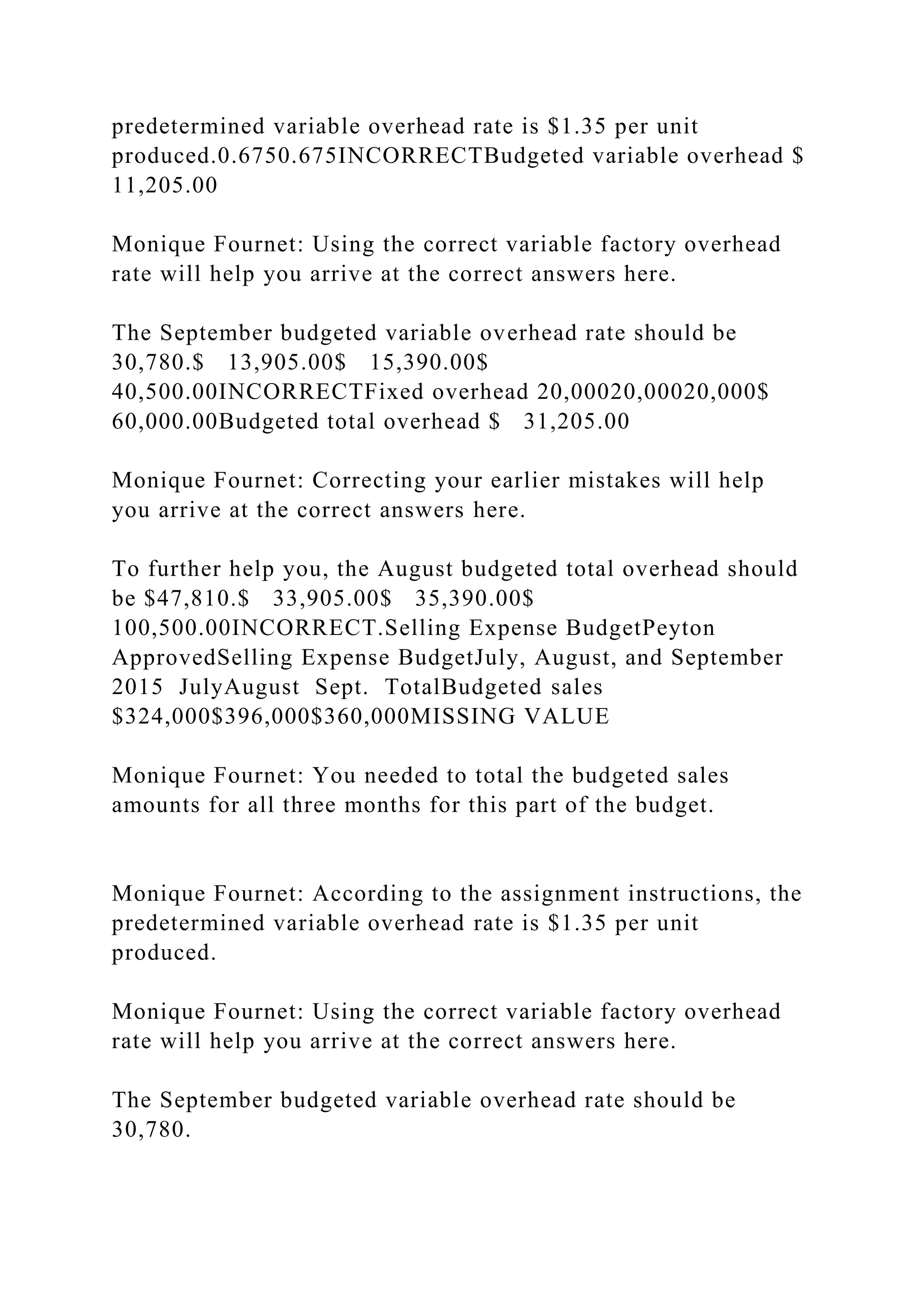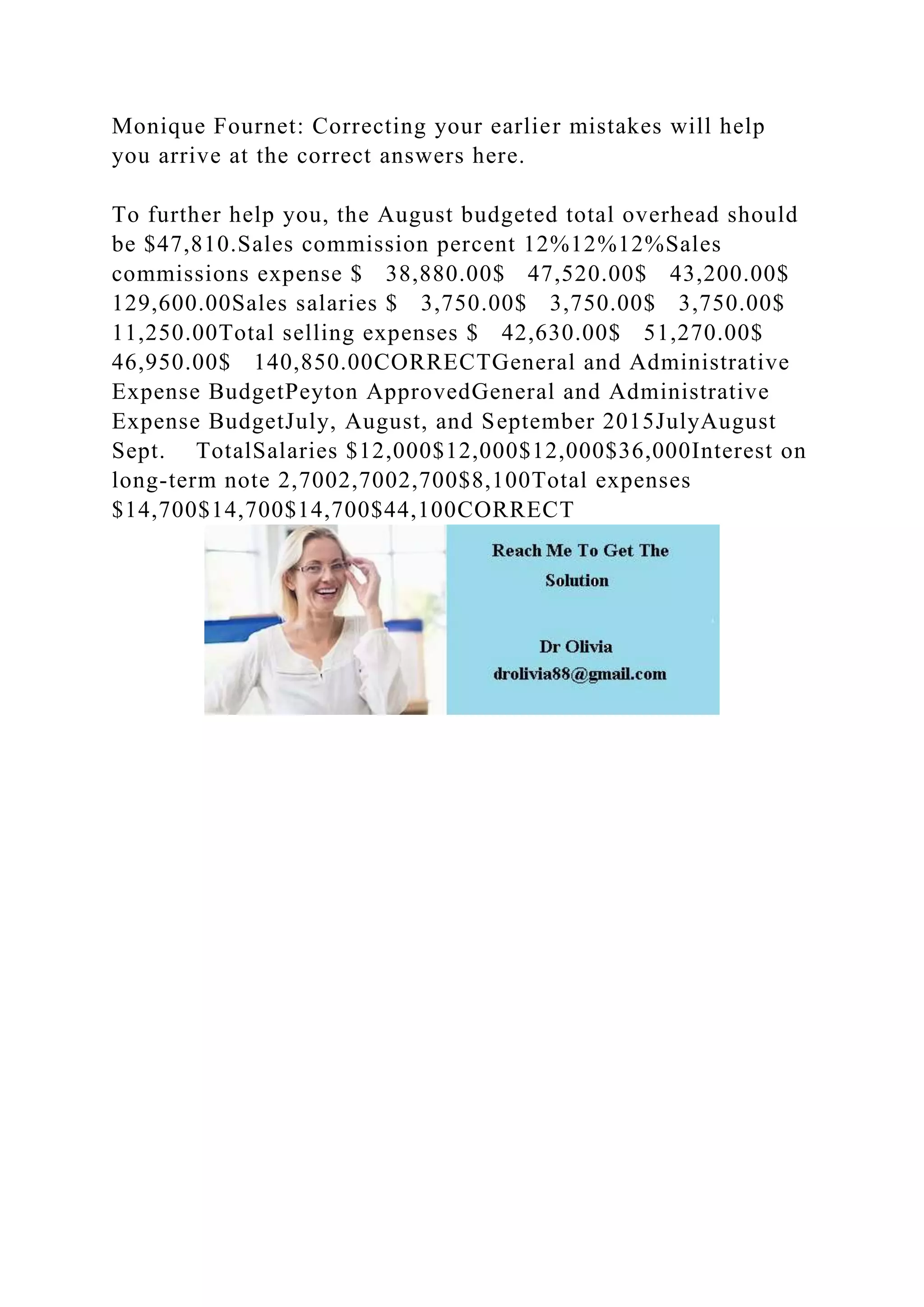The document presents a budget variance report for Peyton Approved, analyzing variances between actual results and budgeted figures for direct materials and labor. Key findings include favorable variances in direct materials efficiency and cost/price but unfavorable labor efficiency variance attributed to potential poor training. Recommendations for improvement include enhancing employee training and seeking quality raw material suppliers at lower costs.

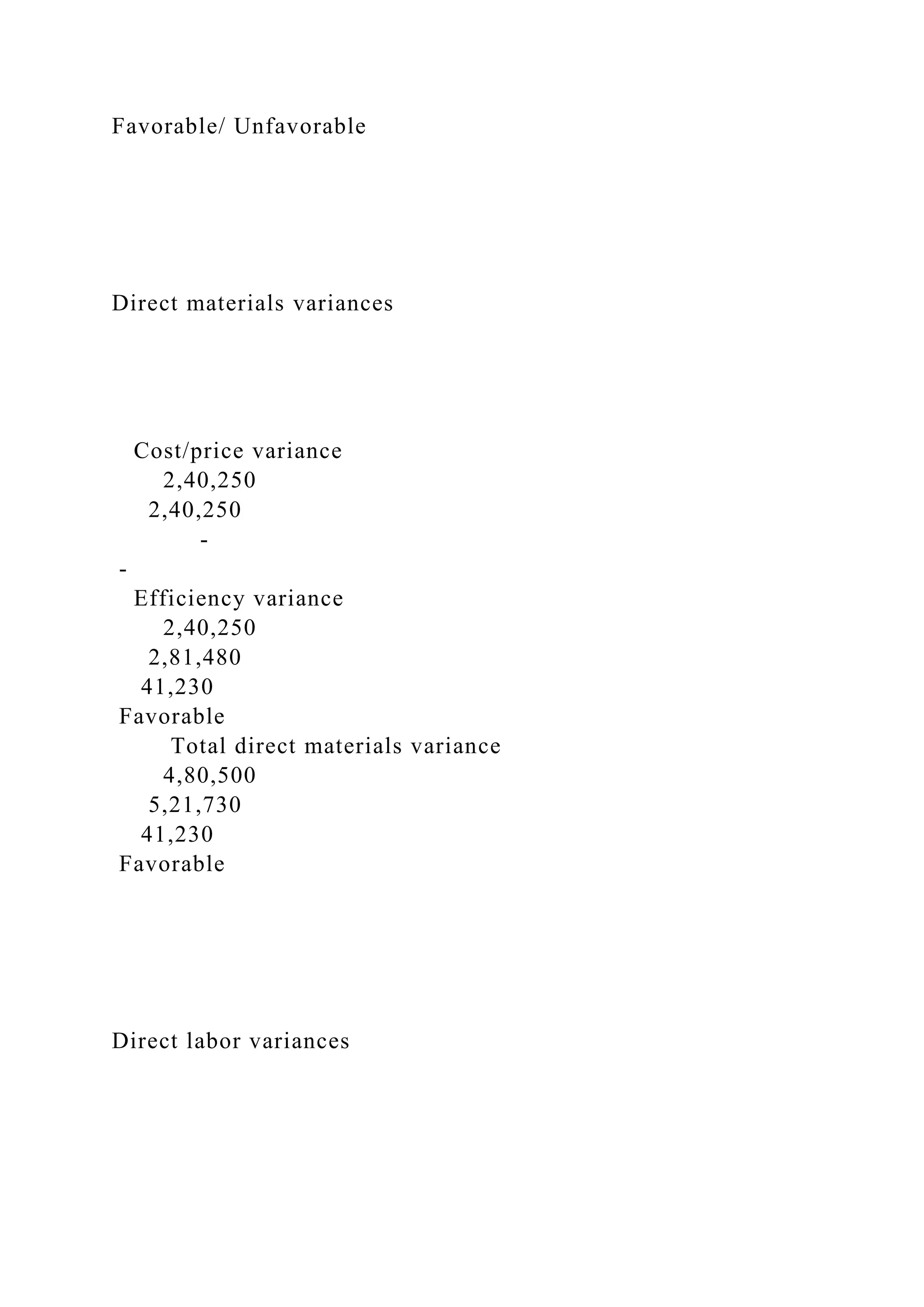
![Cost /price variance
4,95,000
5,28,000
33,000
Favorable
Efficiency variance
5,28,000
4,80,000
(48,000)
Unfavorable
Total direct labor variance
10,23,000
10,08,000
(15,000)
Unfavorable
[Please refer to my comments in your budget variance
worksheet to help you ensure that the figures in this table are
correct.]
The main reasons for the above variances are as under follows:
Material Variances:
· Cost/Price Variance: AThe variance is zero. This means there
has been no change in (the) per unit cost of material.
· Efficiency Variance: A favorable efficiency variance provides
for indicates better good management of the materials and usage
of high quality material (missing period)
Labor Variance:
· Cost/ Price Variance: The favorable variance was mainly
because of (a/the) fall in the labour rate.
· Efficiency Variance:Though Although the labor rate has
reduced was lower than what was budgeted, but the efficiency
of the labor is was reduced as (is) evident from (the)
unfavorable (efficiency) variance. One of the reason(s) for same](https://image.slidesharecdn.com/finalprojectpartibudgetvariancereportsubmission-221102052330-c4891118/75/Final-Project-Part-I-Budget-Variance-Report-Submission-docx-3-2048.jpg)
![this could be poor training to of employees.
Changes Required:
On the basis of above (missing comma) the company should try
to improve the labor efficiency by providing them employees
with proper training. Also, the company should find suppliers of
raw materials providing that provide quality material(s) at (a)
lower price (missing comma) or (they should) try to purchase
(materials) in bulk so as to avail take adavantage of discounts.
Conclusion.
Actually, budget operation (construction?) and variance analysis
is are one some of the best accounting techniques in that enable
the business to analyse its pending [This word choice is a little
awkward and confusing.] resources and make changes where
applicable.Peyton Approved should (make) adjust(ments) on to
(its) labor (training?) and suppliers of raw materials so as it (the
company?) works effectively.
This is a good start. However, for this assignment, you need to
use your words (in sentence/paragraph format) to describe the
variances you found. You need to do this in order to
demonstrate to me your understanding of the course concepts.
Thus, you should describe how you calculated the variances and
what the variances tell you about the company’s operations.
You also need to provide more detail on the potential causes for
the variances you found and what should be investigated by the
company in order to determine the specific causes of the
variances (i.e., what parts of the company’s operations should
management examine).
You need to provide more detail on why the potential causes
you identified could be responsible for the variances you
observed (i.e., why do you think that training is the reason for](https://image.slidesharecdn.com/finalprojectpartibudgetvariancereportsubmission-221102052330-c4891118/75/Final-Project-Part-I-Budget-Variance-Report-Submission-docx-4-2048.jpg)
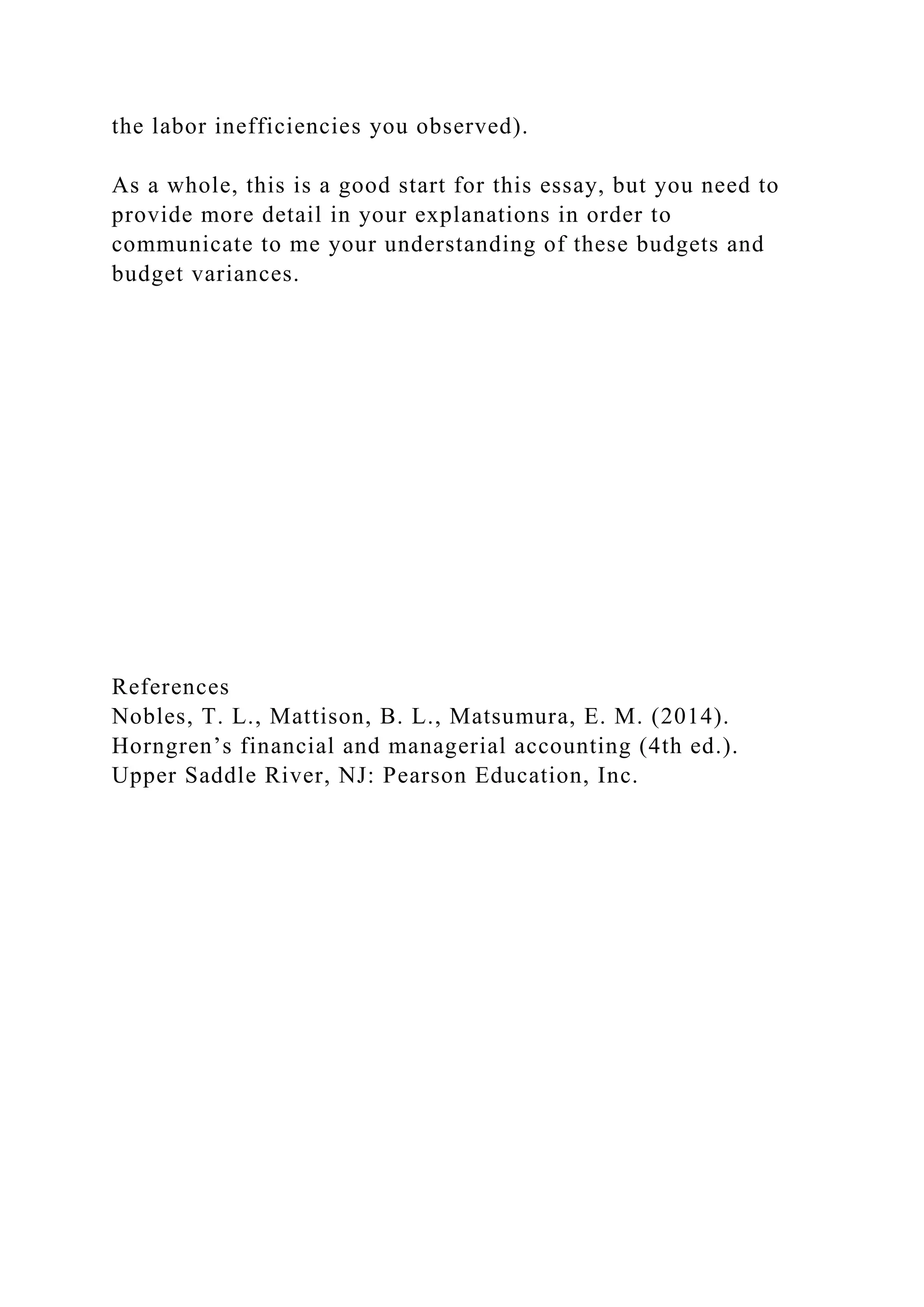
![Budget Variance ReportPeyton ApprovedBudget Variance
ReportFor the Year Ended …Actual ResultsStatic
BudgetVarianceFavorable/ UnfavorableDirect materials
variances Cost/price variance240,250240,250Missing Value
Monique Fournet: You should report your cost/price variance
[(AC x AQ) - (AQ x SC)] here. Missing Value
Monique Fournet: Here, you should indicate whether the
cost/price variance is favorable (0 and above) or unfavorable
(below 0).Incorrect Efficiency variance240,250281,480
Monique Fournet: These cells should be blank.41,230
Monique Fournet: Your efficiency variance [(AQ x SC) - (SC x
SQ)] belongs here.Favorable
Monique Fournet: Correcting your variances will help you
arrive at the correct answers here.Incorrect Total direct
materials variance480,500
Monique Fournet: This is where your 240,250 figure
belongs.521,730
Monique Fournet: Here is where you should report the total
direct materials variance for your static budget (SC x
SQ).41,230](https://image.slidesharecdn.com/finalprojectpartibudgetvariancereportsubmission-221102052330-c4891118/75/Final-Project-Part-I-Budget-Variance-Report-Submission-docx-6-2048.jpg)
![Monique Fournet: Your total direct materials variance
(cost/price variance - efficiency variance) belongs
here.FavorableIncorrectDirect labor variances Cost /price
variance495,000528,00033,000FavorableIncorrect Efficiency
variance528,000480,000
Monique Fournet: These should be
blank.(48,000)UnfavorableIncorrect Total direct labor
variance1,023,000
Monique Fournet: You should report your 495,000 figure
here.1,008,000
Monique Fournet: This is where you should report your static
budget direct labor variance (SC x SQ).
Monique Fournet: You should report your cost/price variance
[(AC x AQ) - (AQ x SC)] here.
Monique Fournet: These cells should be blank.
Monique Fournet: This is where your 240,250 figure belongs.
Monique Fournet: Here, you should indicate whether the
cost/price variance is favorable (0 and above) or unfavorable
(below 0).
Monique Fournet: Your efficiency variance [(AQ x SC) - (SC x
SQ)] belongs here.
Monique Fournet: Here is where you should report the total
direct materials variance for your static budget (SC x SQ).
Monique Fournet: Correcting your variances will help you
arrive at the correct answers here.](https://image.slidesharecdn.com/finalprojectpartibudgetvariancereportsubmission-221102052330-c4891118/75/Final-Project-Part-I-Budget-Variance-Report-Submission-docx-7-2048.jpg)
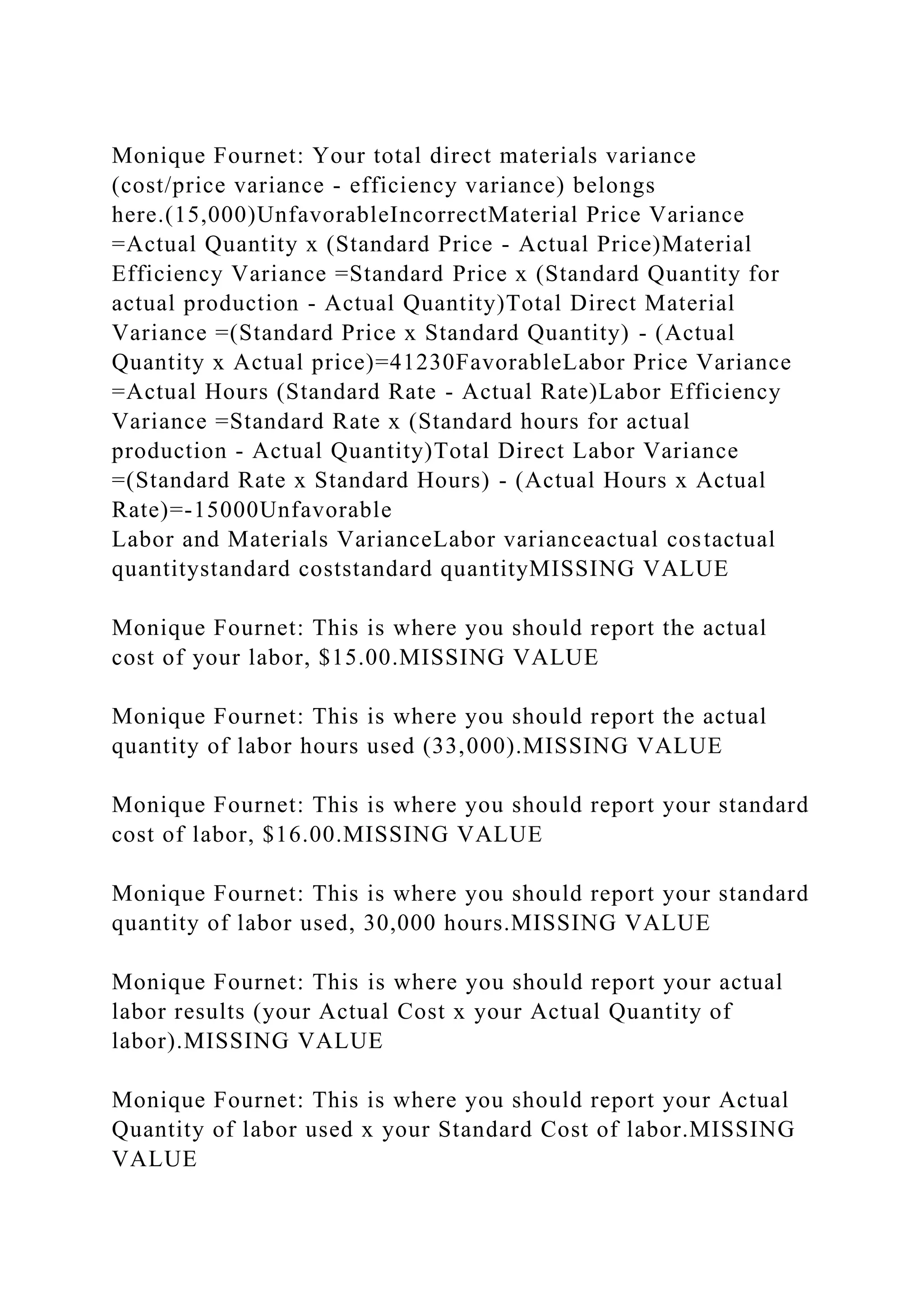
![Monique Fournet: This is where you should report your
budgeted (standard) labor cost x your budgeted (standard) labor
quantity.15
Monique Fournet: This belongs under "actual cost."
Monique Fournet: This is where you should report your standard
cost of labor, $16.00.
Monique Fournet: This is where you should report your Actual
Quantity of labor used x your Standard Cost of labor.33,00016
Monique Fournet: Here, you need to report the efficiency
variance for your direct labor. You calculate this by:
[(Standard Cost x Standard Quantity) - (Actual Quantity x
Standard Cost)]30,000
Monique Fournet: This figure belongs under "standard
quantity."MISSING VALUE
Monique Fournet: You need to indicate whether the variance
you found was favorable (0 and above) or unfavorable.
Monique Fournet: This is where you should report your standard
quantity of labor used, 30,000 hours.
Monique Fournet: This is where you should report your
budgeted (standard) labor cost x your budgeted (standard) labor
quantity.
Monique Fournet: Here, you need to report the efficiency
variance for your direct labor. You calculate this by:
[(Standard Cost x Standard Quantity) - (Actual Quantity x](https://image.slidesharecdn.com/finalprojectpartibudgetvariancereportsubmission-221102052330-c4891118/75/Final-Project-Part-I-Budget-Variance-Report-Submission-docx-9-2048.jpg)
![Standard Cost)]MISSING VALUE
Monique Fournet: Again, you need to indicate whether the
variance you found is favorable or unfavorable.
Monique Fournet: This figure belongs under "standard
quantity."MISSING VALUE
Monique Fournet: You need to report your total direct labor
variance here. Materials varianceactual costactual
quantitystandard coststandard quantityMISSING VALUE
Monique Fournet: You should report your actual cost for your
direct materials, $7.75, here. MISSING VALUE
Monique Fournet: Here, you should report your actual quantity
of materials used, 31,000. MISSING VALUE
Monique Fournet: You need to report the standard (budgeted)
cost of the direct materials, $7.75, here.7.75
Monique Fournet: This belongs under "actual cost."
Monique Fournet: Here, you should report your actual quantity
of materials used, 31,000. MISSING VALUE
Monique Fournet: Here, you should report your Actual Cost of
your materials x your Actual Quantity of materials used.31,000
Monique Fournet: This belongs under "actual quantity."
Monique Fournet: You need to report the standard (budgeted)
cost of the direct materials, $7.75, here. MISSING VALUE
Monique Fournet: Here, you need to report the Actual Quantity
of materials used x the Standard Cost of the materials.7.75](https://image.slidesharecdn.com/finalprojectpartibudgetvariancereportsubmission-221102052330-c4891118/75/Final-Project-Part-I-Budget-Variance-Report-Submission-docx-10-2048.jpg)
![Monique Fournet: This belongs under "standard cost."
MISSING VALUE
Monique Fournet: Here, you need to report the (Standard Cost x
Standard Quantity) figure.36,320
Monique Fournet: This should be under "standard quantity."
MISSING VALUE
Monique Fournet: Here, you should report your cost/price
variance, which is calculated by:
[(Actual Cost x Actual Quantity) - (Actual Quantity x Standard
Cost)]
Monique Fournet: This belongs under "standard cost."
MISSING VALUE
Monique Fournet: You should report your direct materials
efficiency variance here. This is calculated by:
[(Standard Cost x Standard Quantity) - [Actual Quantity x
Standard Cost] MISSING VALUE
Monique Fournet: You need to indicate whether the variance
you found is favorable (0 and above) or unfavorable.
Monique Fournet: Here is where you should report your
Standard Quantity for direct materials, 36,320.
Monique Fournet: Here, you need to report the (Standard Cost x
Standard Quantity) figure.
Monique Fournet: You should report your direct materials
efficiency variance here. This is calculated by:](https://image.slidesharecdn.com/finalprojectpartibudgetvariancereportsubmission-221102052330-c4891118/75/Final-Project-Part-I-Budget-Variance-Report-Submission-docx-11-2048.jpg)
![[(Standard Cost x Standard Quantity) - [Actual Quantity x
Standard Cost]
Monique Fournet: This should be under "standard quantity."
MISSING VALUE
Monique Fournet: You need to indicate whether the variance
you found is favorable or unfavorable. MISSING VALUE
Monique Fournet: You should report your total direct materials
variance here. This is calculated by:
[(Actual Cost x Actual Quantity) - (Standard Cost x Standard
Quantity)]
Sheet3
InstructionsYou are a manager for Peyton Approved, a pet
supplies manufacturer. This responsibility requires you to create
budgets, make pricing decisions, and analyze the results of
operations to determine if changes need to be made to make the
company more efficient.
You will be preparing a budget for the quarter July through
September 2015. You are provided the following information.
The budgeted balance sheet on June 30, 2015, is:Peyton
ApprovedBudgeted Balance Sheet30-Jun-15ASSETSCash
$42,000Accounts receivable259,900Raw materials
inventory35,650Finished goods inventory 241,080Total current
assets 578,630Equipment $720,000Less accumulated
depreciation 240,000480,000Total assets
$1,058,630LIABILITIES AND EQUITYAccounts
payable$63,400Short-term notes payable24,000Taxes payable
10,000Total current liabilities 97,400Long-term note payable
300,000 Total liabilities397,400Common stock
$600,000Retained earnings 61,230Total stockholders’
equity661,230Total liabilities and equity$1,058,630All](https://image.slidesharecdn.com/finalprojectpartibudgetvariancereportsubmission-221102052330-c4891118/75/Final-Project-Part-I-Budget-Variance-Report-Submission-docx-12-2048.jpg)

